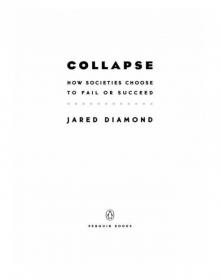- Home
- Jared Diamond
Collapse: How Societies Choose to Fail or Succeed Page 9
Collapse: How Societies Choose to Fail or Succeed Read online
Page 9
The largest group of immigrants consists of “half-retirees” or early retirees in the age bracket 45-59, supporting themselves by real estate equity from their out-of-state homes that they sold, and often also by income that they continue to earn from their out-of-state businesses or Internet businesses. That is, their sources of support are immune to the economic problems associated with Montana’s environment. For example, a Californian who sells a tiny house in California for $500,000 can use that money in Montana to buy five acres of land with a large house and horses, go fishing, and support herself in her early retirement with savings and with what remains of her cashed-out California house equity. Hence nearly half of the recent immigrants to the Bitterroot have been Californians. Because they are buying Bitterroot land for its beauty and not for the value of the cows or apples that it could produce, the price that they are willing to offer for Bitterroot land bears no relation to what the land would be worth if used for agriculture.
But that huge jump in house prices has created a housing problem for Bitterroot Valley residents who have to support themselves by working. Many end up unable to afford houses, having to live in mobile homes or recreational vehicles or with their parents, and having to hold two or three jobs simultaneously to support even that spartan lifestyle.
Naturally, these cruel economic facts create antagonism between the old-time residents and the new arrivals from out-of-state, especially rich out-of-staters who maintain a second, third, or even fourth home in Montana (in addition to their homes in San Francisco, Palm Springs, and Florida), and who visit for just short periods each year in order to fish, hunt, golf, or ski. The old-timers complain about the noisy private jet planes flying rich visitors in and out of Hamilton Airport within a single day from their home in San Francisco, just to spend a few hours playing golf at their fourth home on the Stock Farm. Old-timers resent outsiders buying up large former farms that local residents would also like to buy but can no longer afford, and on which the locals could formerly get permission to hunt or fish, but now the new landowners want to hunt or fish there exclusively with their rich friends and keep out the locals. Misunderstandings arise from the clash of values and expectations: for instance, newcomers want elk to come down from the mountains to ranch areas, because they look pretty or in order to hunt them, but old-timers don’t want elk to come down and eat their hay.
Rich out-of-state homeowners are careful to stay in Montana for less than 180 days per year, in order to avoid having to pay Montana income tax and thereby to contribute to the cost of local government and schools. One local told me, “Those outsiders have different priorities from us here: what they want is privacy and expensive isolation, and they don’t want to be involved locally except when they take their out-of-state friends to the local bar to show their friends the rural lifestyle and the quaint local people. They like wildlife, fishing, hunting, and the scenery, but they’re not part of the local community.” Or, as Emil Erhardt said, “Their attitude is, ‘I came here to ride my horse, enjoy the mountains, and go fishing: don’t bother me with issues I moved here to get away from.’ ”
But there’s another side to the rich out-of-staters. Emil Erhardt added, “The Stock Farm provides employment with high-paying jobs, it pays a high fraction of the property taxes for the whole Bitterroot Valley, it pays for its own security staff, and it doesn’t make many demands on the community or on local government services. Our sheriff doesn’t get called to the Stock Farm to break up bar fights, and Stock Farm owners don’t send their children to the schools here.” John Cook acknowledged, “The plus side of those rich owners is that if Charles Schwab hadn’t bought up all that land, it wouldn’t still be providing wildlife habitat and green open space, because that land would otherwise have been subdivided by some developer.”
Because the rich out-of-staters were attracted to Montana by its beautiful environment, some of them take good care of their property and become leaders in defending the environment and instituting land planning. For example, my summer home for the last seven years has been a rented house situated on the Bitterroot River south of Hamilton, and belonging to a private entity called the Teller Wildlife Refuge. Otto Teller was a rich Californian who liked to come to Montana to fish for trout. One day, he was infuriated to encounter large construction machinery dumping dirt into one of his favorite fishing holes on the Gallatin River. He became further enraged when he saw how massive clear-cutting carried out by logging companies in the 1950s was devastating his beloved trout streams and damaging their water quality. In 1984 Otto began buying up prime riverside land along the Bitterroot River and incorporated it into a private wildlife refugee, which he nevertheless let local people continue to visit in order to hunt and fish. He ultimately donated conservation easements on his land to a non-profit organization called the Montana Land Reliance, in order to ensure that the land would be managed in perpetuity so as to preserve its environmental qualities. Had Otto Teller, that wealthy Californian, not bought that 1,600 acres of land, it would have been subdivided for small house lots.
The influx of newcomers, the resulting rise in land prices and property taxes, the poverty of Montana old-timer residents, and their conservative attitude towards government and taxes (see below) all contribute to the plight of Montana schools, which are funded largely by property taxes. Because Ravalli County has so little industrial or commercial property, the main source of property taxes there is residential property taxes, and those have been rising with the increase in land values. To old-timers and less affluent newcomers already on a tight budget, every increase in property taxes is a big deal. Not surprisingly, they often react by voting against proposed school bonds and supplemental local property tax levies for their schools.
As a result, while public schools account for two-thirds of Ravalli County local government spending, that spending as a percentage of personal income stands last among 24 rural western U.S. counties comparable to Ravalli County, and personal income itself is low in Ravalli County. Even by the low school-funding standards of the state of Montana, Ravalli County school funding stands out as low. Most Ravalli County school districts keep their spending down to the absolute minimum required by Montana state law. The average salaries of Montana schoolteachers rank among the lowest in the U.S., and especially in Ravalli County those low salaries plus soaring land prices make it hard for teachers to afford housing.
Montana-born children are leaving the state because many of them aspire to non-Montana lifestyles, and because those who do aspire to Montana lifestyles can’t find jobs within the state. For instance, in the years since Steve Powell graduated from Hamilton High School, 70% of his classmates have left the Bitterroot Valley. Without exception, all of my friends who chose to live in Montana discussed, as a painful subject, whether their children had remained or would come back. All eight of Allen and Jackie Bjergo’s children, and six of Jill and John Eliel’s eight children, are now living outside Montana.
To quote Emil Erhardt again, “We in the Bitterroot Valley export children. Outside influences, like TV, have now made our children aware of what’s available outside the valley, and what’s unavailable inside it. People bring their children here because of the outdoors, and because it’s a great place to bring up kids, but then their children don’t want the outdoors.” I recall my own sons, who love coming to Montana to fish for two weeks in the summer but are accustomed to the urban life of Los Angeles for the rest of the year, expressing shock as they came out of a Hamilton fast-food restaurant and realized how few urban recreational opportunities were available to the local teenagers who had just waited on them. Hamilton has the grand total of two movie theatres, and the nearest mall is 50 miles away in Missoula. A similar shock grows on many of those Hamilton teenagers themselves, when they travel outside Montana and realize what they are missing back at home.
Like rural western Americans in general, Montanans tend to be conservative, and suspicious of governmental regulation. That attitude arose h
istorically because early settlers were living at low population density on a frontier far from government centers, had to be self-sufficient, and couldn’t look to government to solve their problems. Montanans especially bristle at the geographically and psychologically remote federal government in Washington, D.C., telling them what to do. (But they don’t bristle at the federal government’s money, of which Montana receives and accepts about a dollar-and-a-half for every dollar sent from Montana to Washington.) In the view of Montanans, the American urban majority that runs the federal government has no comprehension of conditions in Montana. In the view of federal government managers, Montana’s environment is a treasure belonging to all Americans and is not there just for the private benefit of Montanans.
Even by Montana standards, the Bitterroot Valley is especially conservative and anti-government. That may be due to many early Bitterroot settlers having come from Confederate states, and to a further influx of bitter right-wing conservatives from Los Angeles after that city’s race riots. As Chris Miller said, “Liberals and Democrats living here weep as they read the results after each election, because the outcomes are so conservative.” Extreme proponents of right-wing conservativism in the Bitterroot are members of the so-called militias, groups of landowners who hoard weapons, refuse to pay taxes, keep all others off their property, and are variously tolerated or else regarded as paranoid by other valley residents.
One consequence of those political attitudes in the Bitterroot is opposition to governmental zoning or planning, and a feeling that landowners should enjoy the right to do whatever they want with their private property. Ravalli County has neither a county building code nor county-wide zoning. Outside of two towns plus voluntary zoning districts formed by local voters in some rural areas outside towns, there aren’t even any restrictions on the use to which land can be put. For instance, one evening when I was visiting the Bitterroot with my teenaged son Joshua, he read in the newspaper that a movie he had wanted to see was playing in one of Hamilton’s two movie theatres. I asked for directions to that theatre, drove him there, and discovered to my astonishment that it had been built recently in an area otherwise consisting entirely of farmland, except for an adjacent large biotechnology laboratory. There were no zoning regulations about that changed use of farmland. In contrast, in many other parts of the U.S. there is sufficient public concern about loss of farmland that zoning regulations restrict or prohibit its conversion to commercial property, and voters would be especially horrified at the prospect of a theatre with lots of traffic next to a potentially sensitive biotechnology facility.
Montanans are beginning to realize that two of their most cherished attitudes are in direct opposition: their pro-individual-rights anti-government-regulation attitude, and their pride in their quality of life. That phrase “quality of life” has come up in virtually every conversation that I have had with Montanans about their future. The phrase refers to Montanans’ being able to enjoy, every day of their lives, that beautiful environment which out-of-state tourists like me consider it a privilege to be able to visit for a week or two each year. The phrase also refers to Montanans’ pride in their traditional lifestyle as a rural, low-density, egalitarian population descended from old-timer settlers. Emil Erhardt told me, “In the Bitterroot people want to maintain the essence of a rural quiet little community in which everyone is in the same condition, poor and proud of it.” Or, as Stan Falkow said, “Formerly, when you drove down the road in the Bitterroot, you waved at any car that passed, because you knew everyone.”
Unfortunately, by permitting unrestricted land use and thereby making possible an influx of new residents, Montanans’ long-standing and continuing opposition to government regulation is responsible for degradation of the beautiful natural environment and quality of life that they cherish. This was best explained to me by Steve Powell: “I tell my real estate agent and developer friends, ‘You have to protect the beauty of the landscape, the wildlife, and the agricultural land.’ Those are the things that create property value. The longer we wait to do planning, the less landscape beauty there will be. Undeveloped land is valuable to the community as a whole: it’s an important part of that ‘quality of life’ that attracts people here. With increasing growth pressure, the same people who used to be anti-government are now concerned about growth. They say that their favorite recreation area is becoming crowded, and they now admit that there have to be rules.” When Steve was a Ravalli County commissioner in 1993, he sponsored public meetings just to start discussion of land use planning and to stimulate the public to think about it. Tough-looking members of the militias came to those meetings to disrupt them, openly carrying holsters with guns in order to intimidate other people. Steve lost his subsequent bid for reelection.
It’s still unclear how the clash between this resistance to government planning and that need for government planning will be resolved. To quote Steve Powell again, “People are trying to preserve the Bitterroot as a rural community, but they can’t figure out how to preserve it in a way that would let them survive economically.” Land Lindbergh and Hank Goetz made essentially the same point: “The fundamental problem here is how we hang on to these attractions that brought us to Montana, while still dealing with the change that can’t be avoided.”
To conclude this chapter about Montana, largely related in my words, I’ll now let four of my Montanan friends relate in their own words how they came to be Montanans, and their concerns for Montana’s future. Rick Laible is a newcomer, now a state senator; Chip Pigman, an old-timer and a land developer; Tim Huls, an old-timer and a dairy farmer; and John Cook, a newcomer and a fishing guide.
Here is Rick Laible’s story: “I was born and brought up in the area around Berkeley, California, where I have a business manufacturing wooden store fixtures. My wife Frankie and I were both working hard. One day, Frankie looked at me and said, ‘You’re working 10 to 12 hours a day, seven days a week.’ We decided to semi-retire, drove 4,600 miles around the West to find a place to settle, bought our first house in a remote part of the Bitterroots in 1993, and moved to a ranch that we bought near the town of Victor in 1994. My wife raises Egyptian Arabian horses on the ranch, and I go back to California once a month for my business that I still own there. We have five children. Our oldest son always wanted to move to Montana, and he manages our ranch. The other four of our kids don’t understand the Montana quality of life, don’t understand that Montanans are nicer people, and don’t understand why their parents moved here.
“Nowadays, after each of my monthly four-day visits to California, I want to get out of there: I feel, ‘They’re like rats in a cage!’ Frankie goes back to California only twice a year to see her grandchildren, and that’s enough of California for her. As an example of what I don’t like about California, I was recently back there for a meeting, and I had a little free time, so I took a walk on the town street. I noticed that people coming in the other direction lowered their eyes and avoided eye contact with me. When I say ‘good morning’ to people that I don’t know in California, they’re taken aback. Here, in the Bitterroot, it’s the rule that when you pass someone that you don’t know, you make eye contact.
“As for how I got into politics, I’ve always had many political opinions. The state assembly legislator for my district here in the Bitterroots decided not to run and suggested to me that I run instead. He tried to convince me, and so did Frankie. Why did I decide to run? It was ‘to put something back’—I felt that life has been good to me, and I wanted to make life better for local people.
“The legislative issue in which I’m particularly interested is forest management, because my district is forested and many of my constituents are woodworkers. The town of Darby, which lies in my district, used to be a rich lumber town, and forest management would create jobs for the valley. Originally, there were about seven lumber mills in the valley, but now there are none, so the valley has lost those jobs and infrastructure. The decisions about forest management h
ere are currently made by environmental groups and the federal government, with the county and state being excluded. I’m working on forest management legislation that would involve collaboration between the three lead parties within the state: federal, state, and county agencies.
“Several decades ago Montana was among the top 10 U.S. states in its per-capita income; now, it stands 49 out of 50, because of the decline of the extraction industries (logging, coal, mines, oil, and gas). Those lost jobs were high-paying union jobs. Of course, we should not go back to over-extraction, of which there was some in the old days. Here in the Bitterroot, both a husband and wife have to work, and often they each have to hold two jobs, in order to make ends meet, yet here we are surrounded by this over-fueled forest. Everybody here, environmentalists or not, agrees that we need some fuel reduction in our forests. Forest restoration would eliminate overfueling of the forests, especially of the low small trees. Now, that overfueling is eliminated just by burning it. The federal government’s National Fire Plan would do it by mechanical extraction of the logs, the purpose being to reduce the biomass of fuel. Most of our American timber comes from Canada! Yet the original mandate of our national forests was to provide a steady stream of timber, and to provide watershed protection. It used to be that 25% of the revenue from national forests went to schools, but that national forest revenue has decreased greatly recently. More logging would mean more money for our schools.

 Why Is Sex Fun?: The Evolution of Human Sexuality
Why Is Sex Fun?: The Evolution of Human Sexuality Guns, Germs, and Steel: The Fates of Human Societies
Guns, Germs, and Steel: The Fates of Human Societies Collapse: How Societies Choose to Fail or Succeed
Collapse: How Societies Choose to Fail or Succeed The Third Chimpanzee: The Evolution and Future of the Human Animal
The Third Chimpanzee: The Evolution and Future of the Human Animal The World Until Yesterday: What Can We Learn From Traditional Societies?
The World Until Yesterday: What Can We Learn From Traditional Societies? The Rise and Fall of the Third Chimpanzee
The Rise and Fall of the Third Chimpanzee Upheaval: Turning Points for Nations in Crisis
Upheaval: Turning Points for Nations in Crisis Guns, Germs, and Steel
Guns, Germs, and Steel The Third Chimpanzee for Young People
The Third Chimpanzee for Young People Why Is Sex Fun?
Why Is Sex Fun?